Elegoo Resin test
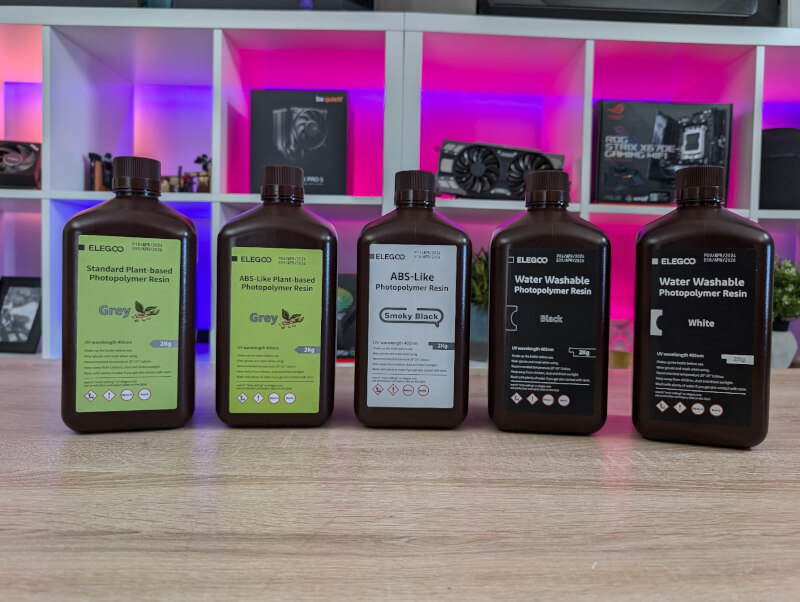
Today we take a look at a selection of different 3D Print resin types from Elegoo. We look partly at how easy they are to print with, whether there is any noticeable difference in the details, on the finished prints and not least how durable they are.
Water Washable or regular resin
One of the very large categories within 3D Print resin is the separation between the ordinary types of resin, which must be post-treated with alcohol or the like, and then Water Washable types, which can be post-treated with ordinary water.
On the surface, it sounds appealing to use Water Washable resin, as this way you can avoid the strong chemicals that ordinary resin types require. It is both cheaper and smells significantly less than normal resin.
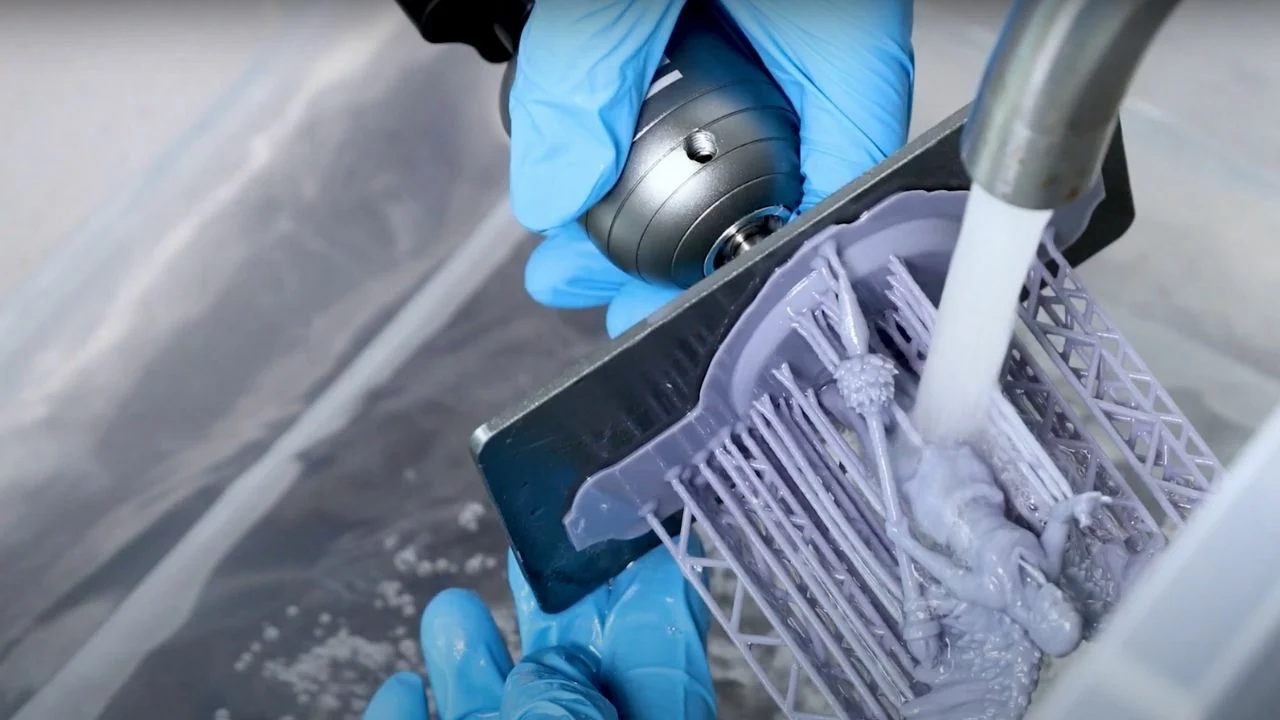
However, Water Washable resin typically has a reputation for being more fragile than regular resin. It can therefore be a bad choice for prints that have to be handled a lot, or smaller prints such as game characters.
As I said, ordinary resin requires alcohol or the like. to clean your prints when they are finished. Of course, it costs money and smells significantly more than water. However, it is also a resin type, which in many contexts is said to be more durable than Water Washable.
Or at least that's how it used to be. Today we take a look at whether that theory still holds when we compare both types.
An IMPORTANT note about 3D Print Resin
It is important to emphasize that uncured resin is a toxic substance and you should therefore use the right protection, such as gloves, etc., when handling it. The same applies to the waste products that come out of it when you clean your resin 3D Print.
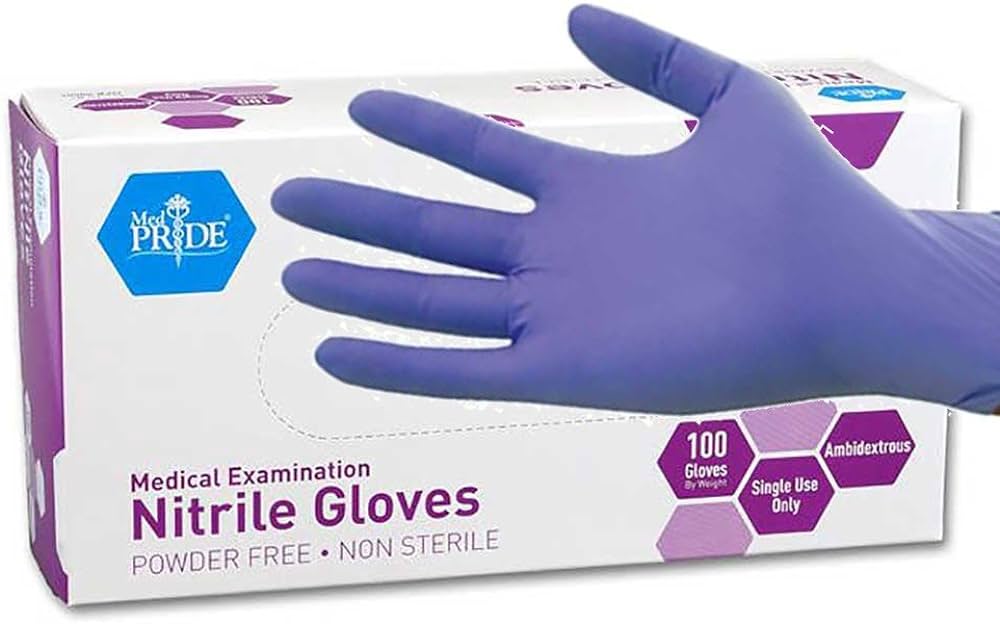
This applies regardless of whether you use ordinary resin or Water Washable types of resin. Even plant-based or Eco resin types must be considered toxic, and therefore resin residues and contaminated cleaning liquid must NOT be poured into the sewer or nature, as it can harm animals and the aquatic environment.
Instead, you have to get rid of things like chemicals, via your local recycling station. So even Water Washable resin must therefore be considered toxic. So it is NOT possible to simply rinse them under the tap, as some manufacturers otherwise show in their material.
Standard or ABS-Like
Another separation that you can run into with 3D Print resin is the division between types that are typically indicated as "standard" and then "ABS-Like"
ABS-Like are resin types that refer to the more durable ABS type of plastic filament used in FDM printing. It is therefore a resin type which is designed to be more durable than the standard types.
One of the disadvantages of ABS-Like resin has been that they have a reputation for being able to lose a bit of detail in favor of improved durability. So it ends up being a question of whether you want to go for super crisp details, or a more durable print.
In today's comparison, I naturally also take a closer look at whether that comparison holds up.
The candidates
Elegoo has sent a selection of their different resin types. It is a mix of Plant based resin, water washable, standard and ABS-Like.
We have a total of seven candidates to take a closer look at in the comparison.
- Elegoo Standard 2.0 (Grey) - Elegoo's primary standard resin and the resin with which I personally have the most experience.
- Elegoo Standard Plat-based (Grey) - A plant-based version of Elegoo's normal standard resin.
- Elegoo Rapid Standard Resin (Grey) - A standard resin designed to print quickly. This is mostly expressed in the fact that this resin is clearly thinner than other types.
- Elegoo Water Washable (White) - Elegoo's Water washable version of their standard resin.
- Elegoo ABS-Like Plant-based (Grey) - A plant-based ABS-Like that combines plant-based ingredients with high durability.
- Elegoo ABS-Like 3.0 (Yellow) - Elegoo's newest formula for tough resin.
- Elegoo ABS-Like (Smoky Black) - Another ABS-Like resin, this time in a more standard formula.
The test
My comparison of the different resin types has, as I touched on earlier, the purpose of looking at how easy they are to print with, whether there is any significant difference in the details of the finished prints, and not least how durable they are .
All my tests with the seven resin types were done on Elego's Mars 5 Ultra printer. I started by finding the optimal exposure time for each of the resin types. It was done in a combination of Cones of Calibration v. 3 from TableFlip Foundry and a two-figure test from Artisans Guild. With the two tests, I was able to tune in to the exposure times, and at the same time I had figures printed, which I will later use to test the durability of the various resins in the test.
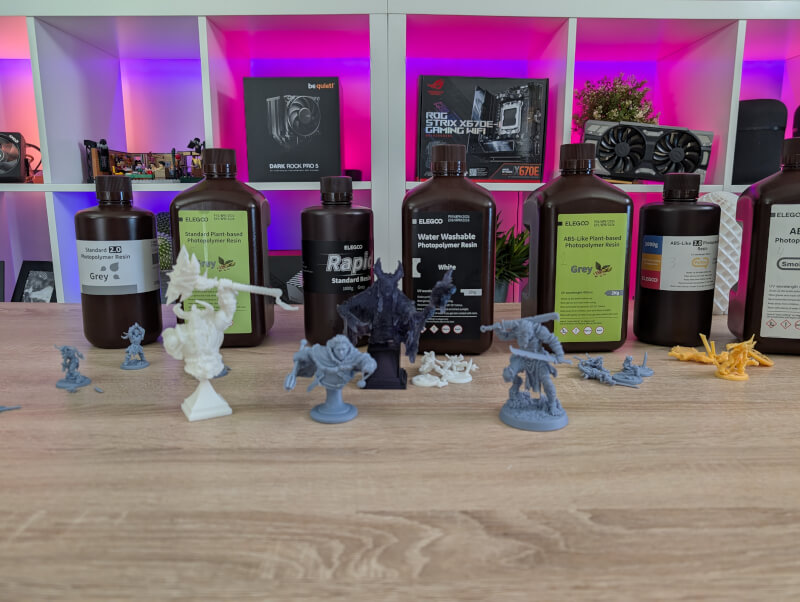
In addition to that, I have also printed a number of different figures on a larger scale. I did this to compare details and double check the settings that I tuned in to.
The exposure times varied quite a lot between top and bottom, but there seems to be a common thread, which I will get into in a bit, when I go through the individual resin types.
Elegoo Standard 2.0 (Grey)
Exposure time: 1.8 seconds
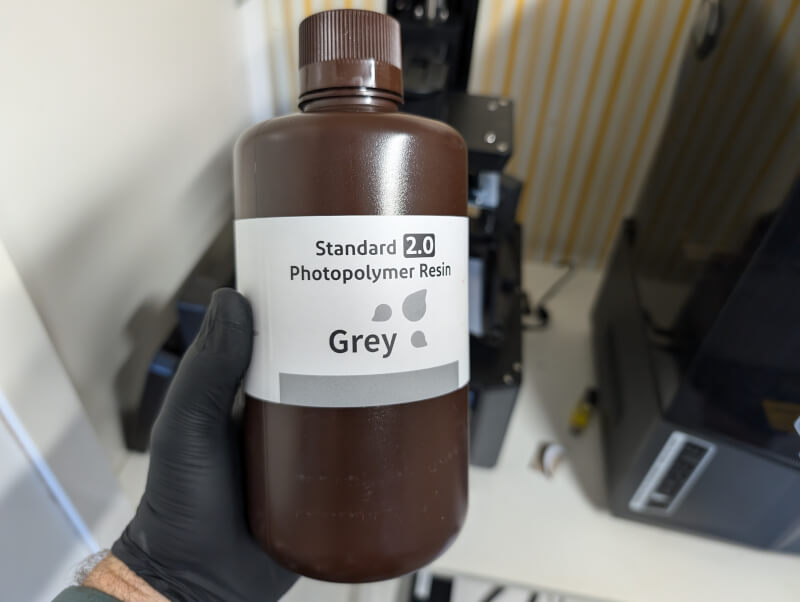
This is an easy resin to go to, in the sense that it was the fastest that I got tuned into. At the same time, it was also the resin that managed the lowest exposure time in the entire test.
The smell of this resin is noticeable and clearly chemical, but I don't find it distinctly unpleasant and mostly when you stand directly next to it and work.
The light gray color also means that it is easy to assess the quality of the prints afterwards.
With the settings that I tuned in, I got prints with a super fine degree of detail and even small details on the test figures were clear afterwards.
Elegoo Standard Plant-based (Grey)
Exposure time: 2 seconds
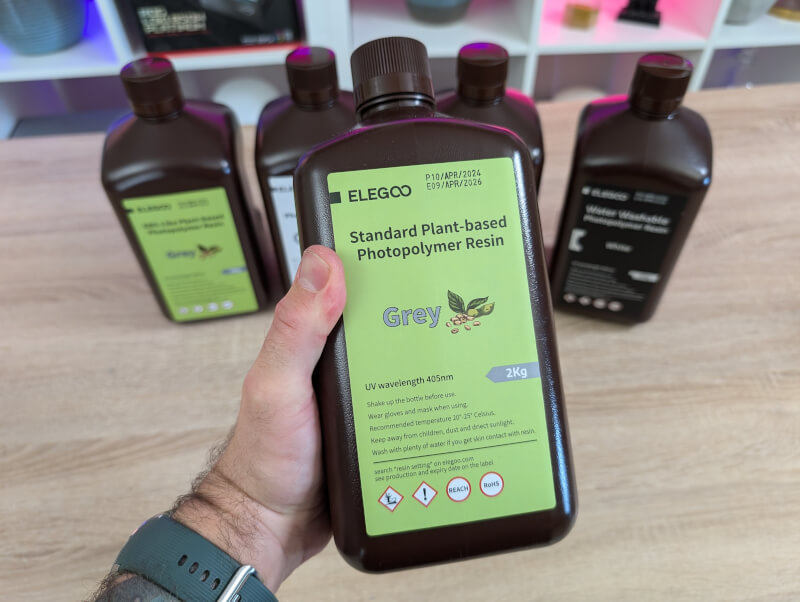
Another resin that is easy to go to. The exposure time had to be increased a little to be sure of success, but it really wasn't much.
The smell is again quite subdued and does not differ much from the regular Standard Resin.
Again, the light gray color is good for our purposes, as the details are subsequently easy to see in the finished prints.
The details do not differ from the regular standard resin. Without marking the printed figures, I couldn't actually tell them apart. So here too you get a resin with a high degree of detail.
Elegoo Rapid Standard Resin (Grey)
Exposure time: 2 seconds
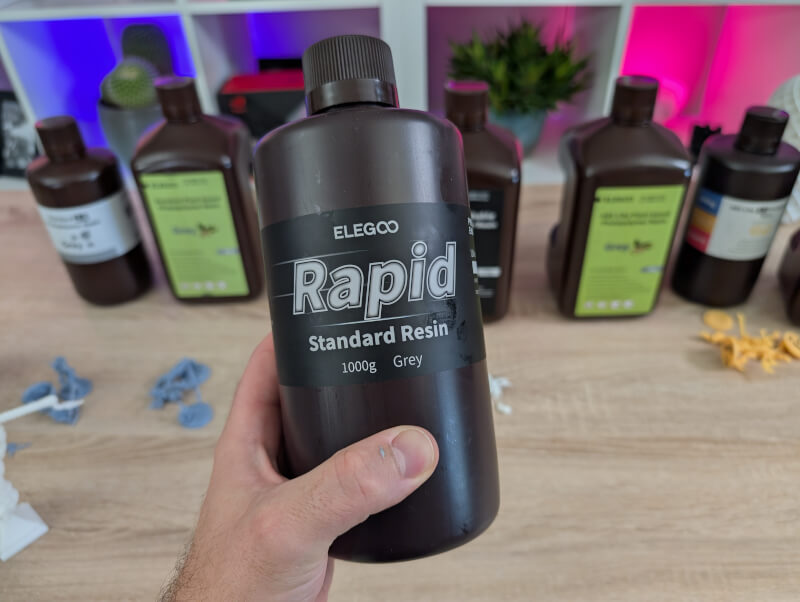
On the surface, another resin that is easy to access with a low exposure time. However, the experience of this resin quickly went in the other direction.
In part, this was clearly the resin in the comparison here, which had the most unpleasant smell.
This was also a resin type which was difficult to work with, as it was already very fragile when the prints had to be peeled off the plate. This meant that the prints were very difficult to get off the plate, as the supports and rafters on my prints simply splintered.
The figure itself survived without too much trouble, but the process of getting them off the slot was super annoying and resulted in me having little shards of hardened resin scattered all over the table.
Elegoo Water Washable (White)
Exposure time: 3.6 seconds.
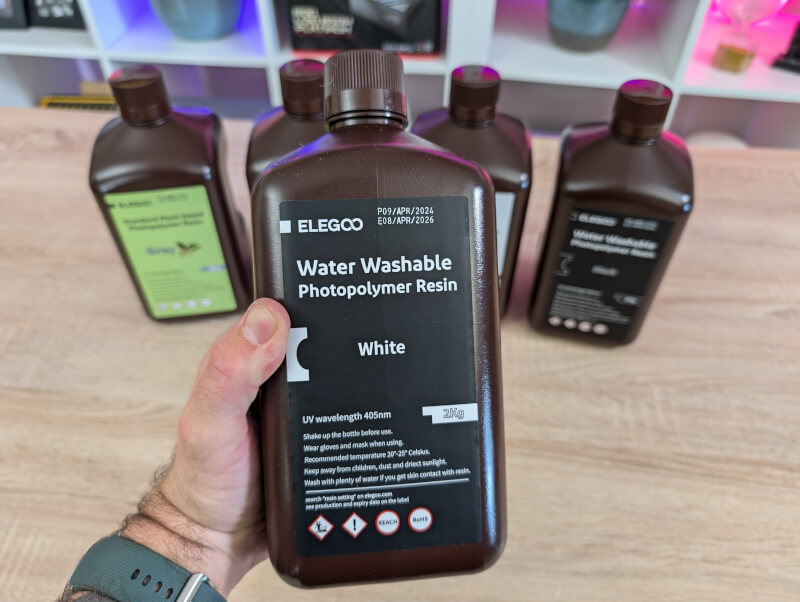
Then we came to the first Water Washable resin in our lineup. Here, however, it quickly turned out that I had to increase the exposure time a big bump before I got useful results out of it. This resin ended up topping the list with an exposure time of 3.6 seconds.
Here it must also be said that the color of the resin can affect the exposure times slightly. How much it has played a role here, versus the resin type, I can't say, as I only had this one color.
The white color also meant that it was somewhat more difficult for me to assess the details of the print afterwards. By turning and rotating it under the light, however, I could not immediately see any great difference in the level of detail. All this despite the fact that the exposure is close to twice as high as the shortest in our comparison.
The smell of this resin is not very different from the regular standard resin. Personally, I don't think it's particularly powerful.
Apart from the longer exposure time, it was a resin that was easy to work with.
Elegoo ABS-Like Plant-based (Grey)
Exposure time: 3.2 seconds
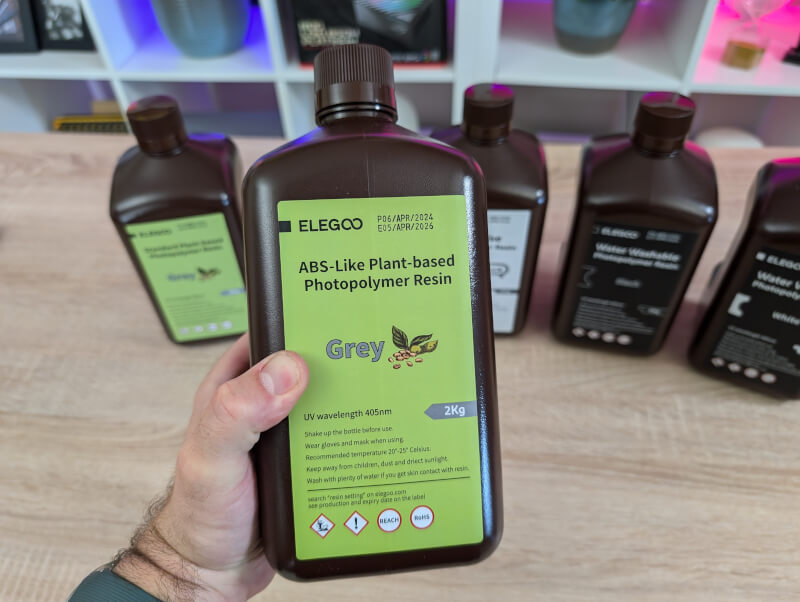
Now we have come to the first ABS-Like resin in the test. I started with the one that was closest to the Standard 2.0 gray resin that I am used to.
On the surface it was pretty much the same with a very similar texture and smell.
If we look at the exposure time, however, we can see that there IS a difference, despite the fact that they visually resemble each other pretty much to the letter.
However, after tuning in to the exposure time, it was very easy to work with and did not give rise to challenges.
The level of detail here is also top notch and cannot be distinguished to the naked eye significantly from any of the others in the test.
Elegoo ABS-Like 3.0 (Yellow)
Exposure time: 3 seconds
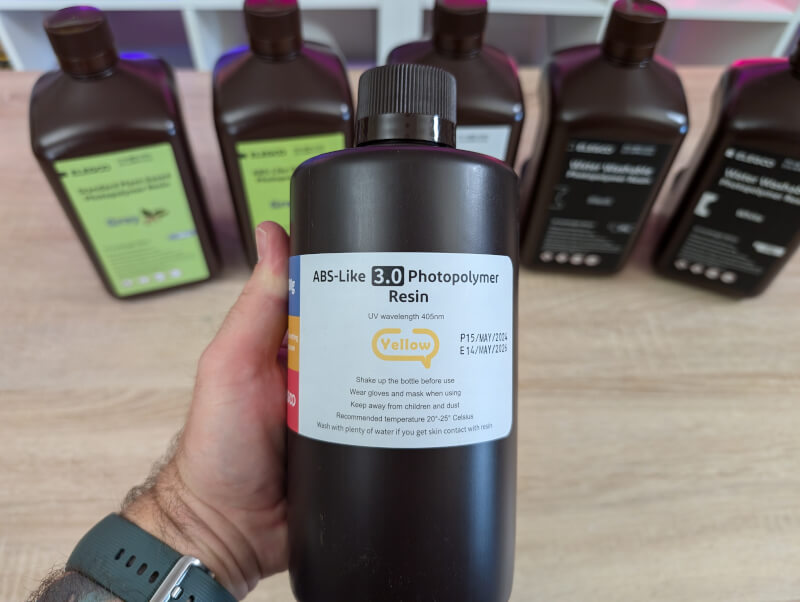
Another ABS-Like resin. This is Elegoo's most updated formula and one must assume the most solid in their ABS segment.
The exposure time could be cut a bit compared to the first ABS-Like in the test.
Odor and consistency do not differ from the others in the test either. The color does, however, on the bottle that we have passed. It is, however, available in other colors as well, if the yellow version we have here does not appeal to you.
Again, there were no problems with getting good prints out of this resin, or with getting the finished prints off the plate and finished.
The level of detail here is also at the same high level as we have seen with the previous resins in the test.
Elegoo ABS-Like (Smoky Black)
Exposure time: 3 seconds
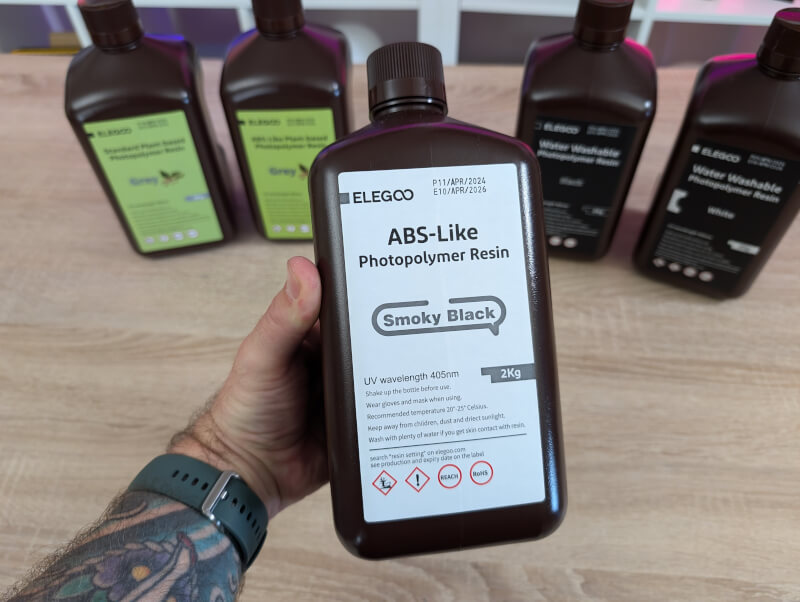
We round off the pack with another ABS-Like resin. This time in Elegoo's standard version in a Smokey Black version. Like the other ABS-Like, we can also see here that it requires a longer exposure time.
Consistency and smell are again not very different from the Standard 2.0 resin that I use as a baseline. It is chemically and definitely present and not something I would use as a deodorant, but a smell I can stand to be around.
Here the color also played a part and made it quite difficult to assess the details afterwards. By turning and turning it under different light, it was still possible to get a good impression. Here, too, the degree of detail was super fine, despite the fact that it was a little difficult to see.
Another thing to note here, which is probably mostly due to the color, is that you must have a very clean cleaning fluid if you want to avoid the print looking a little dirty. I use a two step cleaner for best results, but still there was a bit of residue to be seen on the finished figure.
Durability
In order to test the durability of the different resin types, I have printed a selection of similar figures in each of the different resin types. These are two different 32mm tabletop gaming figures from Artisans Guild.
Both were chosen because they had parts that stick out a little and will therefore be obvious weak points on a figure.
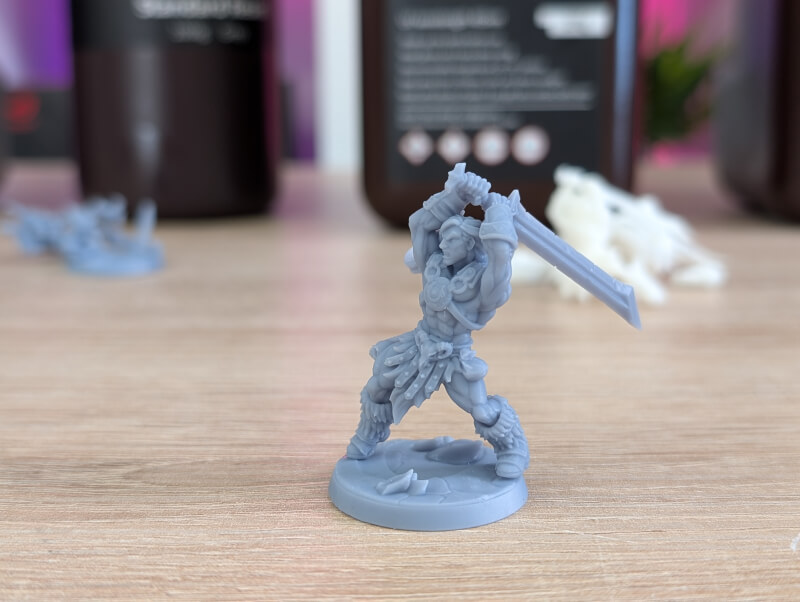
I have done the test in two parts, where I initially test the flexibility of the parts. The more flexible they are, the better they will typically withstand being handled and bumped around on a table.
The second part of the test is a simple drop test, where I let the figures fall to the floor from normal table height (73 cm) and see how they cope with the experience.
Elegoo Standard 2.0 (Grey)
With this resin, the flexibility was not particularly high. So it didn't take much before the parts started to break.
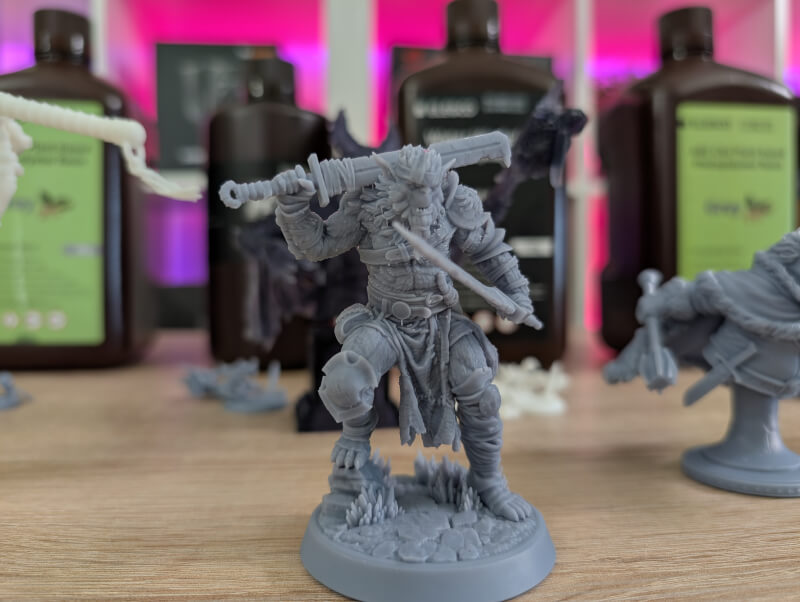
It didn't cope with the drop test particularly well either, and almost every time something of the figures broke.
Elegoo Standard Plat-based (Grey)
Just as I have experienced before, this resin is incredibly similar to Standard 2.0. There is limited flexibility.
This resin also performed poorly on the drop test and none of the figures survived the trip on the floor.
Elegoo Rapid Standard Resin (Grey)
This resin fared even worse than the previous two. Just as I experienced when the finished prints had to be removed from the plate, this resin is very "brittle". This means that the flexibility is poor and the parts break easily.
Here it also completely failed the drop test, with broken figures as a result.
Elegoo Water Washable (White)
I have to admit that I was a little surprised by this resin. Water Washable types have a reputation for being very fragile, but that was not the case here. The flexibility was super good and I almost had to strain to break parts of the figures.
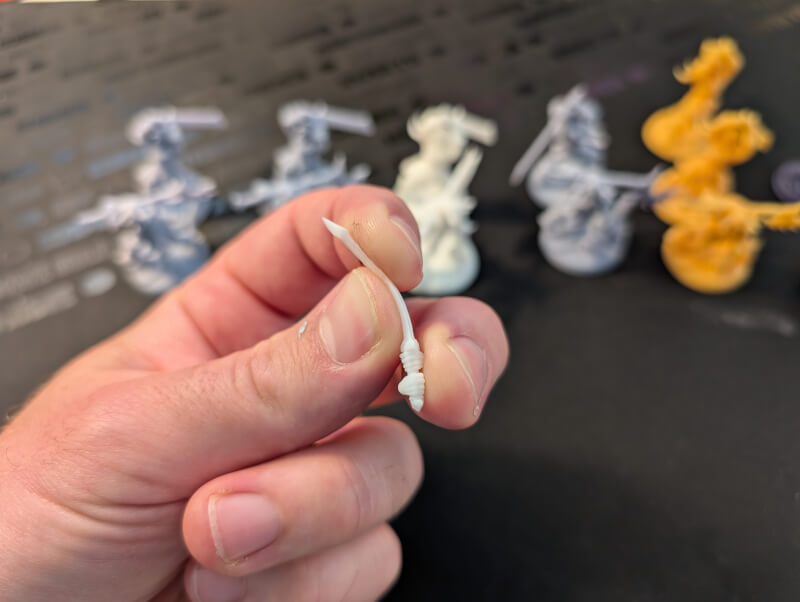
It also performed the drop test a notch better than the two previous resin types. It wasn't immune though, and on the second drop things broke here as well.
Elegoo ABS-Like Plant-based (Grey)
Here we come to the first ABS-Like in our test. In other words, resin that is designed to be more durable.
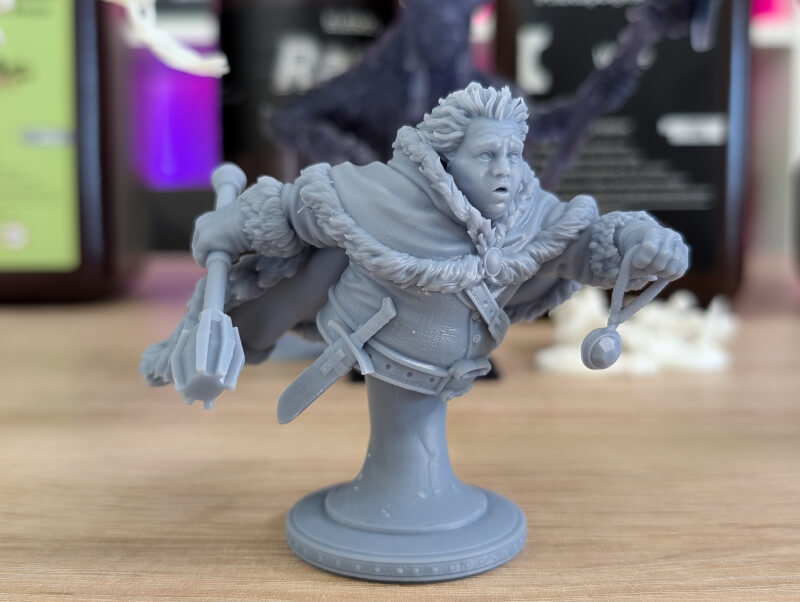
My experience was somewhat twofold, because on the one hand the flexibility was not particularly high. At the same time, however, more pressure had to be applied before the parts actually broke. So it is a resin that is more durable than the standard types.
In the drop test it also performs a bit better. However, it becomes clear quite quickly that even ABS-Like resin printed 32 mm figures are not particularly well suited to being thrown with.
None of the figures survived hitting the floor more than twice before breaking.
Elegoo ABS-Like 3.0 (Yellow)
With Elegoos, on paper, currently the best ABS-like resin, my experience was very much in line with the one I had with the plant-based version before. The flexibility is not particularly high, but more force is needed before parts break.
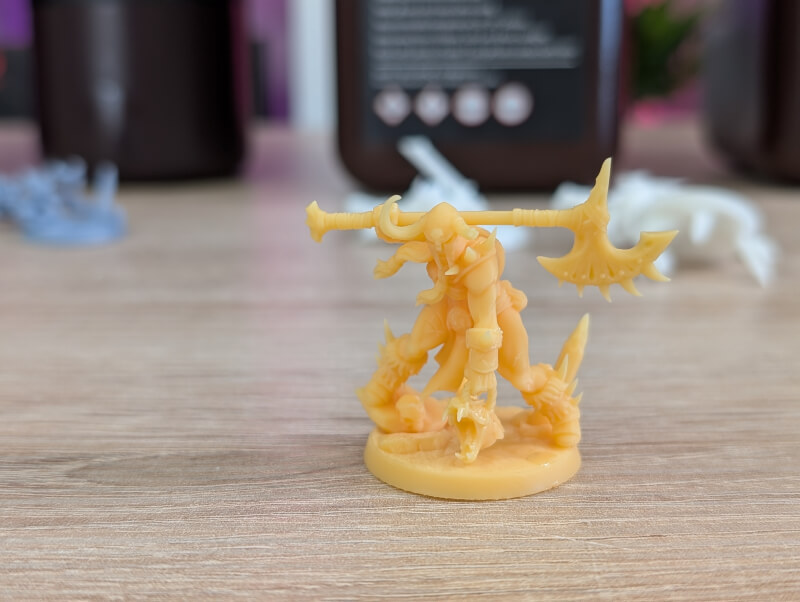
The drop test is also a repeat of the previous one. The durability is better than standard resin, but after two trips on the floor this resin also had to give up.
Elegoo ABS-Like (Smoky Black)
The last ABS-Like in the series stands out a little from the others. Here there was quite a bit more flexibility in the finished figures. That, combined with the fact that correspondingly more force was needed before things actually broke, meant that the overall durability here was greater.
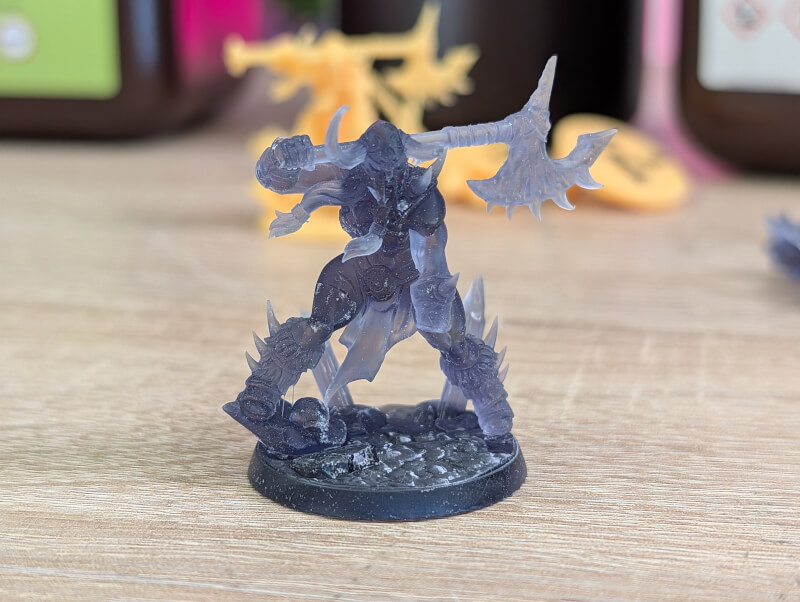
However, the drop test was again too big a mouthful for our brave little figures, who had to die after a few trips on the floor.
Conclusion
So what have I come to, after going through seven different Elegoos 3D Print resin types?
In general, I would say that there is not a great deal of difference across the different types of Elegoos. Naturally, with the caveat that I have not tested their entire range.
I would think it could be because they keep a fairly similar formula on their resin with minor variations distributed over the different types.
However, there are a few common things that we can see across the different types.
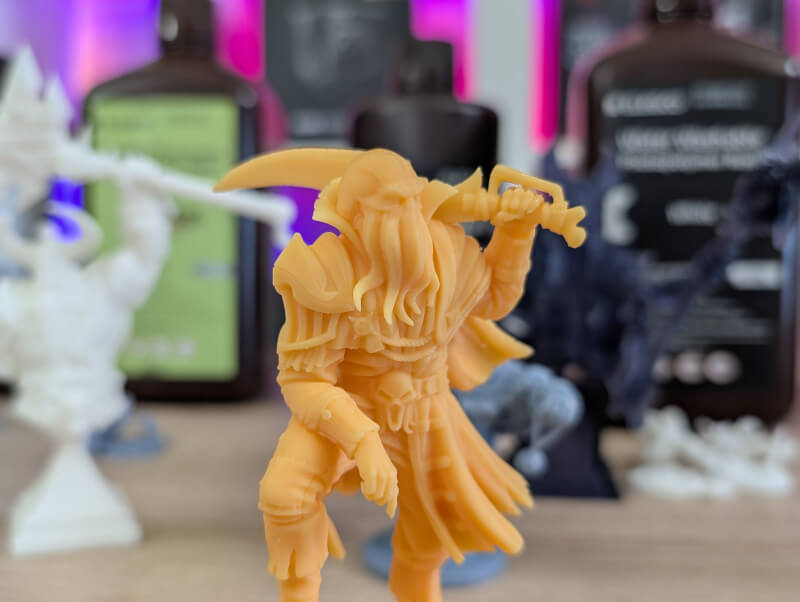
ABS-Like resin from Elegoo must generally have a longer exposure time than Elegoo's Standard 2.0 resin.
Since it does not affect the level of detail to any significant degree in my tests here, it naturally only matters if you want to print really quickly. Over a second more per exposed layer can add up if printing large items.
In my case, it was about half an hour difference between the fastest and the slowest print. Of course, this also means more wear and tear on the LCD screen in your printer.
As I mentioned above, I also did not experience any significant difference in the level of detail and the general visual quality of the prints across the different resin types. Of course, I cannot deny that there are minor differences if you print very detailed models with a lower layer height than I have done in my test here.

If you have to print figures and the like. with a layer height of 0.05 mm, in the same style as I have done here, there is however no real difference between the tested resin types. Not one that I could spot during my testing.
When it comes to durability, the differences were also relatively small. There is clearly a gain in durability when switching to the ABS-Like types compared to the standard types.
However, it is not night and day, and you do not get a durability that can be compared to, for example, plastic. None of my test figures survived repeated drops from table height, regardless of the type of resin used.

The big surprise in my test here was the white Elegoo Water Washable resin. This type has a reputation for being fragile, but it was actually one of the most flexible in my testing. It wasn't terribly much better at surviving the drop test, but it had the best flexibility in the test.
Which resin should you choose?
It will depend a bit on what you value. If you want to print quickly and easily, with a good detailed result, then Standard Resin 2.0 is a good bet.
If you want a slightly more durable, but not immortal result, then ABS-Like 3.0 is also a really good offer. It is actually a bit cheaper than the regular standard resin, but here you have to live with a slightly longer exposure time. This means longer time to print the same models, and a little more wear and tear on your printer's LCD screen.
Finally, based on my test here, I also have nothing to complain about Elegoos Water Washable resin in terms of durability. However, you have to live with a longer exposure time here, and then it is a resin that costs a little more than both the standard and ABS-Like types.
The only resin that I would definitely not recommend is Rapid Standard Resin. It smells more, was difficult to work with and very fragile.
I hope you have been able to use the test here for something, and if nothing else, I have at least learned that not all Water Washable resin types live up to their fragile reputation.
We are working on getting several types of resin from several different manufacturers, so that we can do a wider test at a later date.
Latest printer
-
15 Octprinter
-
10 Octprinter
New arrivals from Bambu Lab
-
02 Octprinter
Bambu Lab opens Flagship Store in China
-
25 Junprinter
Elegoo launches reinforced filament
-
20 Junprinter
Bambu Lab Store turns three years old
-
25 Marprinter
Bambu Lab launches H2D
-
03 Marprinter
The world's first flying 3D printer
-
14 Febprinter
BIQU Panda BuildPlate CryoGrip
Most read printer
Latest printer
-
15 Octprinter
Bambu Lab unveils P2S
-
10 Octprinter
New arrivals from Bambu Lab
-
02 Octprinter
Bambu Lab opens Flagship Store in China
-
25 Junprinter
Elegoo launches reinforced filament
-
20 Junprinter
Bambu Lab Store turns three years old
-
25 Marprinter
Bambu Lab launches H2D
-
03 Marprinter
The world's first flying 3D printer
-
14 Febprinter
BIQU Panda BuildPlate CryoGrip






